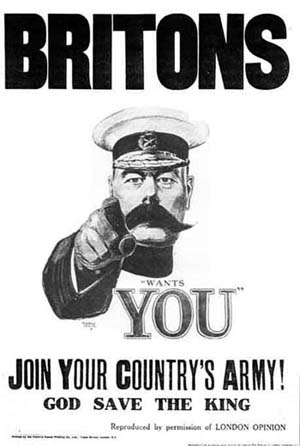 |
| Leete, Alfred. "Lord Kitchener Wants You," 1914. |
The man pictured in what some would describe as the quintessential modern military recruitment poster is none other than Lord Kitchener (1850-1916), one of the most iconic figures of the Great War. Alfred Leete's striking 1914 image features a disembodied head and pointing arm, as though the great man emerges from a foggy blank space to find and address us. We, the viewers, feel somehow more visible under the fierce gaze of this imposing figure, though he appears before us only in partial form.
Kitchener, as his biographical details reveal, was born in Ireland and became a major player in British imperial conquests and conflicts during the nineteenth and early twentieth centuries. In 1914, he was appointed Secretary of State for War.
 |
| "Lord Kitchener Says," Parliamentary Recruiting Comm., Great Britain. Lithograph, 1915. © IWM (Art.IWM PST 0309) |
Kitchener's work as the Secretary of State for War was mired in controversy, primarily because of severe shortages in weapon supplies. The iconic status that had helped to recruit multitudes to the British Army began to shift towards the mid-point of the war. Public sentiment was mixed regarding Kitchener's untimely death en route to Russia in 1916, during an event of staggeringly tragic proportion. The military leader's ship, the HMS Hampshire, struck a German mine and sank near the Orkney islands, killing over six hundred people who were aboard. Jane Storey's commemorative history site offers considerable information and media related to the Hamphire disaster.
 |
| Dick, W. Reid. Kitchener Memorial at All Souls' Chapel, St. Paul's Cathedral, London, 1925. |
Controversy continued to follow Kitchener even after his death, though he was memorialized in grand and prolific fashion. A striking effigy (seen above) was installed as part of the 1925 All Souls' Chapel, which honors Kitchener and all of the war's fallen service-people at St. Paul's Cathedral, London. The effigy takes on a certain irony or strangeness, it is worth noting, in light of the fact that Kitchener's body was never recovered from sea. British Pathé has an impressive set of viewable short films documenting services for and monuments to Kitchener in the 1910s and 20s.
 |
| Kitchener Memorial, Orkney. |
While there are statues, monuments, schools, and other prominent tributes to Kitchener in many places around the world, many other, very different, items commemorating this iconic and somewhat mysterious figure were made during the Great War. Not everyone agreed about the shape or nature of Kitchener's work and legacy, but the small material objects below, all from the Imperial War Museum's collection of ephemera and other objects, indicate a desire to capture his legendary presence in tactile and approachable--even lighthearted--form.
 |
| Kitchener Commemorative Matchbox, 1916. © IWM, Item EPH 1336. |
 |
| Lord Kitchener Toby Jug, Royal Staffordshire Pottery, 1917. © IWM, Item EPH 8729. |
 |
| Lord Kitchener doll, Britain, ca. 1914. © IWM, Item EPH 4083. |
Kitchener's memory shifts through all of these shapes, reminding us of the ways in which the histories of war and the nature of wartime icons seem to resist clear or full materialization even as they are manifested over and over again in material modes--statues, monuments, dolls, ephemera. True form perhaps eludes capture, though (for history enthusiasts like myself) the pursuit never fails to thrill.
© Fiona Robinson
He looks so imposing. Cute figures too. Painters Kitchener could have produce quality paints that could be used to paints this tiny figures.
ReplyDelete